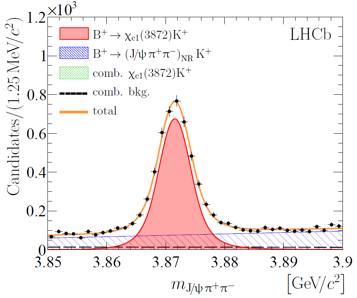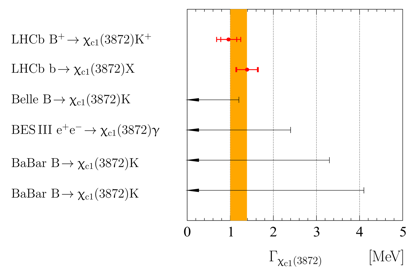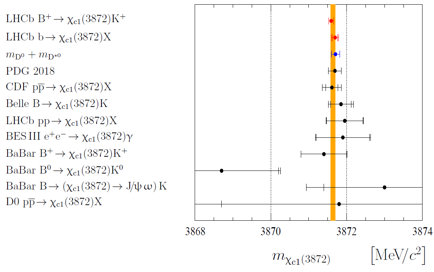Today, the LHCb collaboration submitted two papers reporting precise measurements of the properties of a mysterious particle χc1(3872), also known as the X(3872). These results have also been presented at the conference on Large Hadron Collider Physics, LHCP. Since its discovery 17 years ago physicists try to understand if this particle is a conventional charmonium state composed of c and c quarks or if it is an exotic particle composed of four quarks. An exotic particle of this type could be a tetraquark, a molecular state, a cc gluon hybrid state, a vector glueball or a mixture of different possibilities. A very interesting feature of this particle is that its mass is remarkably close to the sum of the masses of the D0 and D*0 mesons.
The particle was originally discovered in B+ meson decays, specifically the process B+→X(3872)K+, by the BELLE collaboration in 2003. Its existence was later confirmed by the CDF, D0 and BaBar experiments. LHCb first reported studies of the X(3872) in the data sample taken in 2010 (see 27 October 2010 news) and later unambiguously determined its quantum numbers to be 1++. This quantum number determination lead the Particle Data Group to change the name of this particle to χc1(3872). Despite studies of the properties of this particle over 17 years by different experiments at different accelerators its nature is still not definitely understood.
Two different, minimally overlapping data sets were used. First, a Run 1 data set corresponding to an integrated luminosity of 3 fb-1 of data in which about 15 500 χc1(3872) particles were selected from decays of hadrons containing b quarks. Second, the full Run 1 and Run 2 data set corresponding to an integrated luminosity of 9 fb-1 in which about 4 230 B+→χc1(3872)K+ decays were selected. In both cases the χc1(3872) particles were reconstructed in their J/ψπ+π− decay mode. The image shows the accumulation of events around an invariant mass of 3872 MeV in the second data set.
Precise measurements of its parameters, namely the mass and the natural width, are crucial to understanding the nature of χc1(3872). LHCb has announced today the first measurement of the width Γ of this particle. Up to now only the upper limits were reported by different experiments. The width of the particle is related to its lifetime by the basic rules of quantum mechanics. The fact that the mass of the χc1(3872) is close to the sum of the masses of the D0 and D*0 mesons makes this analysis particularly challenging. Two models were used to study the χc1(3872) lineshape (Breit−Wigner and Flatté, for experts). The decay D0D*0 was taken explicitly into account in addition to the J/ψππ decay. The presence of this decay distorts the shape of the signal. This distortion needs to be taken into consideration if one wants to measure the physical mass and the width of the χc1(3872). The left image below shows a summary of the current limits (arrows) and measurements of the χc1(3872) natural width performed by different experiments. The two LHCb entries (red points) correspond to the two LHCb results announced today.
The right image below shows a summary of measurement of the χc1(3872) mass performed by different experiments. The LHCb results (red points) are the most precise. In each plot, the orange band represents the value and the uncertainty on the world average including new LHCb results.
LHCb physicists announced also today that the χc1(3872) mass coincides with the sum of the masses of the D0 and D*0 mesons – the measured difference is only 70±120 keV, see corresponding entry (blue point) in the right plot above.
To understand the nature of the χc1(3872) it is hepful to compare its properties to those of conventional charmonium particles with similar mass. LHCb physicists compared the production of the χc1(3872) with the production of ψ2(3823) and ψ(2S) mesons accompanied by a K+ meson in B+ decays. The decay ψ2(3823)→ J/ψπ+π– is observed for the first time with significance exceeding 5 standard deviations.
These new results from LHCb add new pieces to the χc1(3872) puzzle. The results favour the interpretation of the state as a quasi-bound D0D*0 molecule, however, no final solution has been reached yet. LHCb physicists continue to work on this subject, more results will come in the future and will be reported on this page. The next planned analysis will employ a sophisticated, state-of-the-art amplitude analysis technique to study the χc1(3872) particle. This approach is discussed in detail in one of the papers released today, and is ilustrated by the multicoloured plot shown above.
Details and numerical values can be found in the LHCb papers [1] and [2]. Read more in the CERN Courier article, in the CERN LHCP media update in English and French, and also in LHCb LHCP presentations [1] and [2].




